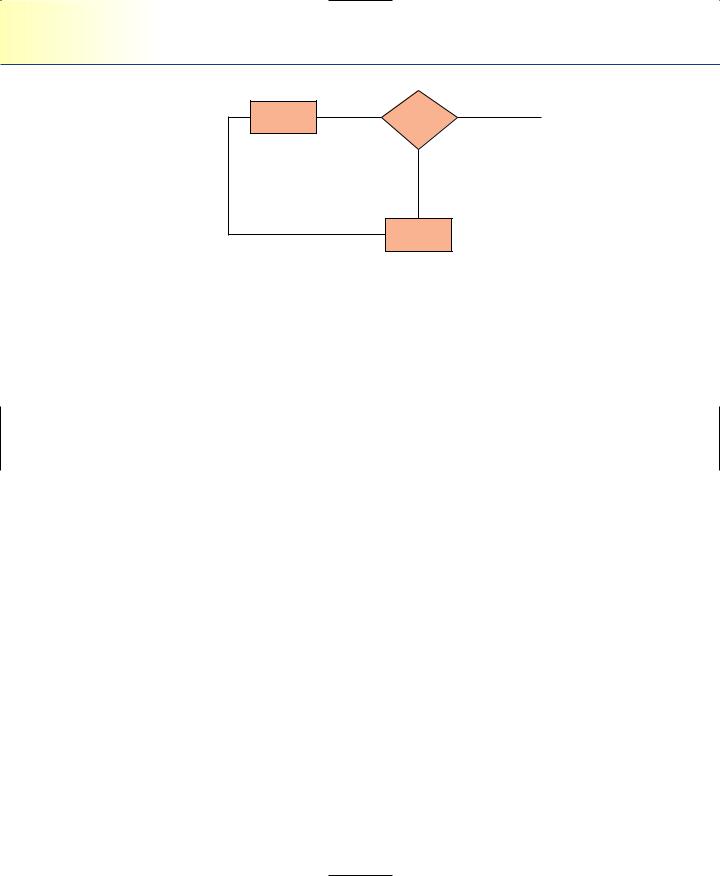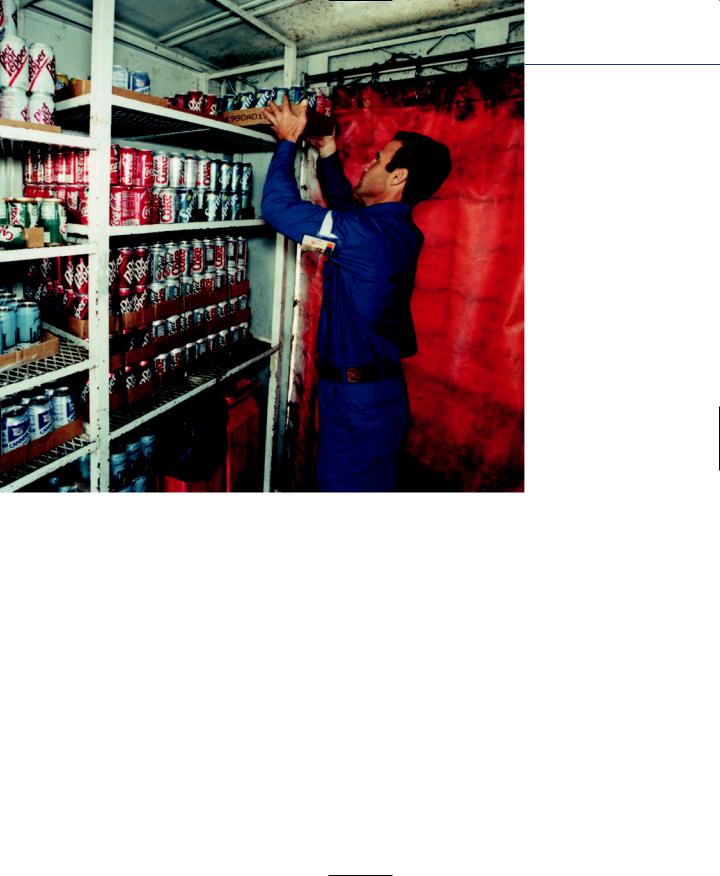
- •CONTENTS
- •PREFACE
- •Content—Benefits for Students
- •Content—Benefits for Instructors
- •Features of the Book for Students and Instructors
- •Supplementary Materials
- •Acknowledgments
- •What Is Hospitality Management?
- •The Manager’s Role in the Hospitality Industry
- •Why Study in a Hospitality Management Program?
- •Planning a Career
- •Employment as an Important Part of Your Education
- •Getting a Job
- •Employment at Graduation
- •The Outlook for Hospitality
- •Summary
- •Managing Change
- •Demand
- •Supply
- •Workforce Diversity
- •The Impact of Labor Scarcity
- •Summary
- •The Varied Field of Food Service
- •The Restaurant Business
- •The Dining Market and the Eating Market
- •Contemporary Popular-Priced Restaurants
- •Restaurants as Part of a Larger Business
- •Summary
- •Restaurant Operations
- •Making a Profit in Food Service Operations
- •Life in the Restaurant Business
- •Summary
- •Chain Restaurant Systems
- •Independent Restaurants
- •Franchised Restaurants
- •Summary
- •Competitive Conditions in Food Service
- •The Marketing Mix
- •Competition with Other Industries
- •Summary
- •Self-Operated Facilities
- •Managed-Services Companies
- •Business and Industry Food Service
- •College and University Food Service
- •Health Care Food Service
- •School and Community Food Service
- •Other Segments
- •Vending
- •Summary
- •Consumer Concerns
- •Food Service and the Environment
- •Technology
- •Summary
- •The Evolution of Lodging
- •Classifications of Hotel Properties
- •Types of Travelers
- •Anticipating Guest Needs in Providing Hospitality Service
- •Service, Service, Service
- •Summary
- •Major Functional Departments
- •The Rooms Side of the House
- •Hotel Food and Beverage Operations
- •Staff and Support Departments
- •Income and Expense Patterns and Control
- •Entry Ports and Careers
- •Summary
- •The Economics of the Hotel Business
- •Dimensions of the Hotel Investment Decision
- •Summary
- •The Conditions of Competition
- •The Marketing Mix in Lodging
- •Product in a Segmented Market
- •Price and Pricing Tactics
- •Place—and Places
- •Promotion: Marketing Communication
- •Summary
- •The Importance of Tourism
- •Travel Trends
- •The Economic Significance of Tourism
- •The United States as an International Tourist Attraction
- •Businesses Serving the Traveler
- •Noneconomic Effects of Tourism
- •Summary
- •Motives and Destinations
- •Mass-Market Tourism
- •Planned Play Environments
- •Casinos and Gaming
- •Urban Entertainment Centers
- •Temporary Attractions: Fairs and Festivals
- •Natural Environments
- •On a Lighter Note. . .
- •Summary
- •Management and Supervision
- •The Economizing Society
- •The Managerial Revolution
- •Management: A Dynamic Force in a Changing Industry
- •What Is Management?
- •Summary
- •Why Study Planning?
- •Planning in Organizations
- •Goal Setting
- •Planning in Operations
- •The Individual Worker as Planner
- •Long-Range Planning Tools
- •Summary
- •Authority: The Cement of Organizations
- •Departmentalization
- •Line and Staff
- •Issues in Organizing
- •Summary
- •Issues in Human-Resources Management
- •Fitting People to Jobs
- •Recruiting
- •Selection and Employment
- •Training
- •Retaining Employees
- •Staff Planning
- •Summary
- •The Importance of Control
- •Control and the “Cybernetic Loop”
- •Tools for Control
- •Summary
- •Leadership as Viewed by Social Scientists
- •Why People Follow
- •Leadership Theories
- •Communication
- •The Elements of Leading and Directing
- •Developing Your Own Leadership Style
- •Summary
- •A Study of Service
- •Rendering Personal Service
- •Managing the Service Transaction
- •How Companies Organize for Service
- •Summary
- •INDEX

608 |
Chapter 19 Control in Hospitality Management |
The Importance of Control
Because specialized courses are taught in the area of control, hospitality students sometimes get the impression that control is separate, something located “over there” in the accounting office. However, as we will see in this chapter, control is an integral part of every manager’s and supervisor’s work: Control is the work that managers and supervisors do to measure performance against standards, detect and ana-
lyze variances from target performance, and initiate corrective action.
Control affects and is affected by all the other functions. For instance, the standards that result from planning are meaningless without some way of measuring performance, just as a set of numbers measuring performance is meaningless without some idea of the results desired (i.e., some standard).
Similarly, a major function of organizing is to fix responsibility for results. Once again, if we have a measure that can tell us something is wrong but no means of saying who takes responsibility for corrective action, the purpose of control will be stymied.
In Chapter 18, we saw that proper staffing is necessary to achieve the productivity that allows us to meet payroll cost targets and that staff planning is the basis for that control. As you read Chapter 20, on the directing and leading function, you will want to remember that information is an important basis for management action. A control system is part of a larger plan to measure performance and make improvements. If control systems yield nothing but numbers, they will be useless. Perhaps an illustration from the personal experience of one of the authors can demonstrate this point best:
I once was hired to relieve a man—let’s call him Mr. Brower—who was the food and beverage manager in a hotel whose food operation was losing money badly. Mr. Brower had received his early training in a well-established hotel company with several operations.
When I was introduced to Mr. Brower, he took me into his office and pulled out a set of ledger books. As he opened the first, he said, “We’ve got a terrific control system. All our food is issued from the storeroom only on requisitions, and the storeroom man sends the requisition slips up to me and I post them. As you can see, we have a daily food cost in 18 categories!”
As I talked further with Mr. Brower, I learned that most of his early experience had been as a food controller—someone responsible for maintaining the food cost accounting system for the hotel where he worked. What he had done

Control and the “Cybernetic Loop” |
609 |
was to come as close to duplicating the elaborate control system at the hotel where he used to work, and then he labored long and hard to maintain the system.
Unfortunately, he had produced a system that told him in great detail that his operation was going broke. He didn’t know what to do about it, so he sat in his office and kept his records straight! The process of untangling the mess involved getting rid of the storeroom man, who really wasn’t needed in an operation of that size (and who had been regularly stealing the food), establishing food and payroll cost standards, and then correcting performance on specific work stations and food products.
Control and the “Cybernetic Loop”
The word cybernetic is derived from the ancient Greek word for the steersman on a ship. In early times, the steersman would aim the ship toward some point on the horizon. If the ship’s course veered to the left, he’d move the tiller to steer a bit to the
right and vice versa.
In modern management, control systems fill a similar function. As an operation progresses, various information about the progress is collected and presented to management in a usable form. If the report indicates that the food cost is on target, management can turn its attention elsewhere. If the food cost is off, however, it’s up to the manager to “move the tiller” and to take corrective action on the basis of the information, just as the steersman reacted when he saw the bow of the ship moving off the point to which he was steering. The term loop is used in conjunction with cybernetic because the process is continuous. Action constantly takes place, and information about that action must constantly pass through the loop to indicate either that the
process is on course or that corrective |
|
|
|
|
|
|
action is required. This constant vigi- |
|
|
|
|
|
|
lance results in more information being |
Cashier’s Report |
|
|
|
||
sent through the loop, and so on. |
|
|
|
|||
Shift: |
A.M. |
|
|
|
||
A simple example of the cyber- |
|
|
|
|||
Cashier: |
Mary |
|
|
|
||
netic loop in action—a cashier’s |
|
|
|
|||
|
|
|
|
|
|
|
report—is shown in Figure 19.1. A sim- |
|
|
Sales |
319.72 |
||
|
|
Cash Deposit |
319.87 |
|||
ple diagram of the cybernetic loop ap- |
|
|
||||
|
|
Over (Short) |
.15 |
|
||
pears in Figure 19.2. |
|
|
|
|||
|
|
|
|
|
|
|
|
|
|
|
|
|
|
|
|
|
|
|
|
|
Mary, a cashier, starts her shift with |
|
|
|
|
|
|
a $100 bank. Throughout her eight-hour |
Figure 19.1 |
|
|
|
||
shift she accepts cash from customers |
Cashier’s report. |
|
|
|
|
|

610 |
Chapter 19 Control in Hospitality Management |
Action |
Is |
if |
continue |
it |
yes |
||
OK? |
|
||
|
|
||
if |
no |
|
|
Corrective
action(s)
Figure 19.2
The cybernetic loop.
who are paying for their meals or making change. As necessary, Mary rings up each sale on a cash register. At the end of her shift, she prepares a report that shows:
1.The amount of sales rung up on the register
2.The amount of money she is depositing (which is always the amount of money in her cash drawer, less her $100 bank)
3.The difference between the sales she has collected and her deposit, or the amount she is over or short
Most cashiers make small errors, and so they may be over or short a few cents. However, if the error is greater than 50 cents (or some other prescribed amount), management approval of the report may be required.
Notice what this procedure accomplishes. If Mary’s report indicates she’s on course, no management action will be needed. If she makes an error over the prescribed amount, management must be informed. Depending on the circumstances, management can accept the error or initiate corrective action. The corrective action is not intended so much to correct an error that has already occurred as it is to find the cause of the error and take steps to avoid it in the future. Once management locates the error that Mary has been making, it can help her avoid it. Thus, control is forward-looking. Control, in effect, records and studies what has happened, not principally to place the blame on someone, but to discover what went wrong so that the error can be avoided in the future. We study the past not for itself but for what it can teach us for the future.
This example also provides a good illustration of an information system, a concept that we’ve encountered repeatedly. An information system collects, transcribes, and summarizes information about transactions or other events and provides

Control and the “Cybernetic Loop” |
611 |
management with a summary for analysis and action. Figure 19.2 shows a simple version of an information system as a cybernetic loop. An action is followed by some test against standards. If the performance is acceptable, the process will continue; if it is not, some corrective action or actions will be taken, and then we will try again.
Information systems are concerned with more than just financial data. For instance, some information systems involve personnel and marketing. Many states have developed nutritional audits for the custodial and health care institutions they operate. These nutritional audits measure not so much the cost of food as the nutritional adequacy of the diets being served.
The key to designing an information system is to determine just what information is needed—or, to use the language of the systems analyst, just what information output is required of the system. An information system, then, is any means of collecting information (cash register tapes, meat yields, guest counts) and translating the raw information into an intelligible, usable summary form. Examples shown in Figure 19.3 are a cashier’s report, a meat yield report, and a summary of guest arrivals per tenminute time segment.
The final element is that the report must go to the right management person to be useful. Figure 19.3 illustrates this simplified concept of a control system using the three examples cited.
Lest the term “information system” discourage a student with its apparent complexity, let us look at some examples of control through management action based on exceedingly simple information systems.
CONTROL THROUGH MANAGEMENT ACTION
Many food service operators have found that the recipe itself can be one key to controlling food quality and reducing waste. At some food service operations, the food production director and other members of the management taste samples of all the food that has been prepared to be sure that it has been prepared correctly. Because these managers are trained to taste (and have tasted the same recipe many times before), what better way to be sure that quality standards have been met?
Recipes also specify portion sizes, but it takes skill to portion correctly when carving a roast, for example, and errors are common. To aid a carver, many operations use the over-and-under portion scale. This scale is actually a simple information system that permits a carver to correct overor underportioning and to know when his or her carving hand has grown a little heavy or a little light. If the person portioning the meat keeps a simple record of how many portions are served from a cut of meat, at the end of the meal a supervisor can prepare a yield report and compare the results (portions served) with the standard that has been established for that product.

The control function includes maintaining proper levels of inventory. (Courtesy of Southwest Airlines.)
Indeed, some food production managers actually study the garbage can. By periodically raking through the garbage, they can see what kind of food and how much of it is being left on plates. If one item consistently becomes waste, it can indicate either poor quality or overportioning. Further study of the information serves as the basis for management action. In short, regular garbage inspection can be part of an information system.
In largeand medium-sized hotels, housekeeping supervisors below the executive housekeeper level are often called inspectors. Their supervisory duties include not only assigning work and issuing supplies but also physically inspecting each room as it is finished to be sure it has been made up to the hotel’s standards and reporting the results to the housekeeper and front desk.
Many hospitals (and other hospitality institutions as well) collect patient comments and tally them. If the dietary department complaint rate suddenly goes up, the dietitian knows there is a problem and can begin the necessary study to correct it. These complaints can become the focus, again, of an information system.
612
